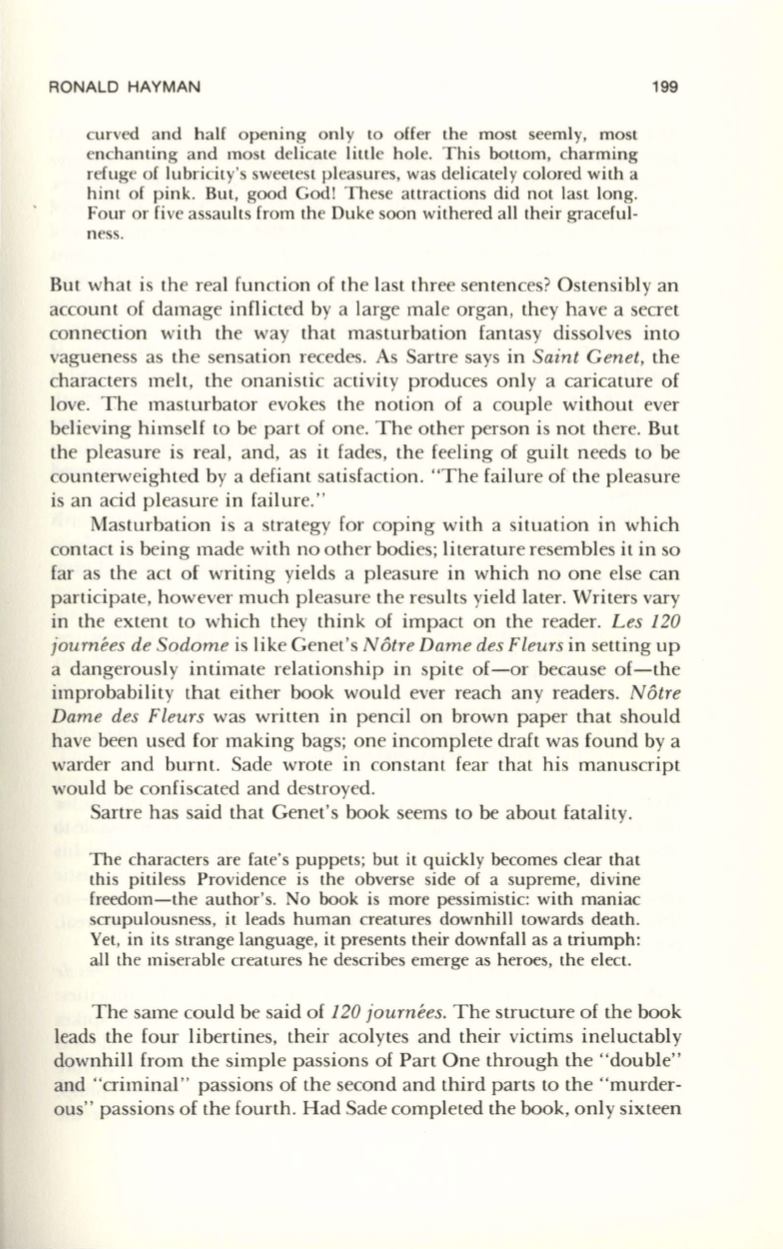
RONALD HAYMAN
curved and half opening only to offer the most seemly, most
enchanting and most delicate little hole. This bottom, charming
refuge of lubricity's sweetest pleasures, was delicately colored with a
hint of pink. But, good God! These attractions did not last long.
Four or five assaults from the Duke soon withered all their graceful–
ness.
199
But what is the real function of the last three sentences? Ostensibly an
account of damage inflicted by a large male organ, they have a secret
connection with the way that masturbation fantasy dissolves into
vagueness as the sensation recedes. As Sarlre says in
Saint Genet,
the
characters melt, the onanistic activity produces only a caricature of
love. The masturbator evokes the notion of a couple without ever
believing himself to be part of one. The other person is not there. But
the pleasure is real , and, as it fades, the feeling of guilt needs
to
be
counterweighted by a defiant satisfaction. "The failure of the pleasure
is an acid pleasure in failure."
Masturbation is a strategy for coping with a situation in which
contact is being made with no other bodies; literature resembles it in so
far as the act of writing yields a pleasure in which no one else can
participate, however much pleasure the results yield later. Writers vary
in the extent to which they think of impact on the reader.
Les 120
joumees de Sodome
is like Genet's
Notre Dame des Fleurs
in setting up
a dangerously intimate relationship in spite of- or because of-the
improbability that either book would ever reach any readers.
Notre
Dame des Fleurs
was written in pencil on brown paper that shou ld
have been used for making bags; one incomplete draft was found by a
warder and burnt. Sade wrote in constant fear that his manuscript
wou ld be confiscated and destroyed.
Sartre has said that Genet's book seems to be about fatality.
The characters are fate's puppets; but it quickly becomes clear that
this pitiless Providence is the obverse side of a supreme, divine
freedom-the author's. No book is more pessimistic: with maniac
scrupulousness, it leads human creatures downhill towards death.
Yet, in its strange language, it presents their downfall as a triumph:
a.ll the miserable creatures he describes emerge as heroes, the elect.
The same could be said of
120 joumees.
The structure of the book
leads the four libertines, their acolytes and their victims ineluctably
downhill from the simple passions of Part One through the "double"
and "criminal" passions of the second and third parts
to
the "murder–
ous" passions of the fourth. Had Sade completed the book, only sixteen


